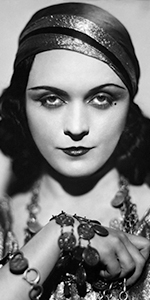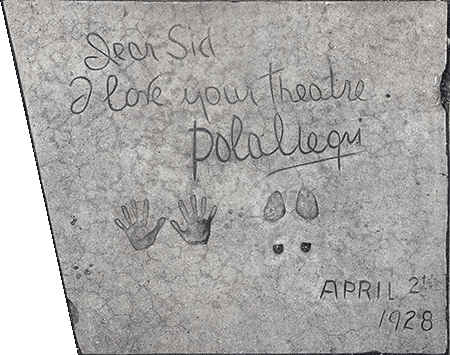 |
 |
 |
 |
 |
| Pola Negri, date unknown. |
| |
|
 |
|
 |
| |
| |
|
|
| Pola Negri |
 |
|
Forecourt Ceremony held on Monday, April 2, 1928 |
| |
Born: Barbara Apolonia Chalupiec, January 3, 1897, in Lipno, Poland
Age at the time of the ceremony: 31
Died: August 1, 1987, in San Antonio, Texas, age 90 |
| |
Pola Negri was a stage and film star in her native Poland until she was swept to Hollywood, where she appeared in many sultry films, causing her to become a fashion icon from the silent era.
She was born in poverty in Lipno Poland, to a tinsmith father who was sent to prison in Siberia. After this, little Barbara and her mother relocated to Warsaw, where the young girl was accepted into the Warsaw Imperial Ballet. She danced as a baby swan in a production of Swan Lake, however she was diagnosed with tuberculosis and sent to a sanitarium to recover. While there, she adopted the last name of Negri.
Upon her release from the sanitarium, Negri began study at the Warsaw Imperial Academy of Dramatic Arts, where she also studied with Honorata Leszcynska. By 1913, she had starred in Gerhardt Hauptmann's play Hannele in Warsaw, and made her first film the following year. She starred as Hedwig in Ibsen's The Wild Duck as her graduating performance at the Academy, which led to offers for her to join theatre troupes. By 1917, she was one of the most popular stage actresses in the country.
Accepting an invitation from Max Reinhardt to come to Berlin to appear in a film, Negri met with director Ernst Lubitsch, with whom she made several feature-length films at the UFA studio: Die Augen der Mumie Ma - The Eyes of the Mummy, released in October 1918), a version of Carmen (released in December 1918), Madame DuBarry (released in September 1919), and Sumurun (released in September 1920). Many of Negri's starring vehicles produced in Germany were distributed in the United States through First National, making Negri a screen personality here without her even having worked in America.
That would change. Her director, Ernst Lubitsch, had been called to Hollywood by Mary Pickford, to direct her in Rosita (released in Setember 1923). Jesse Lasky had seen Madame DuBarry when it played in Berlin; he insisted Paramount offered Negri a contract post-haste. Her arrival in New York City on September 12, 1922, was a major press event. Her first big picture for Paramount was The Spanish Dancer (released in October 1923). It and Rosita were both based on the same Victor Hugo novel, Don César de Bazan. When this battle royale was over, critics said Pickford's film was better, but Negri's version was more entertaining.
Paramount took advantage of Negri's sultry sexuality and exotic vibe, placing her in somewhat contrived films taking place in European high / low society, where she could wear a stunning wardrobe: Shadows of Paris (released in February 1924), Men (released in May 1924), and Lily of the Dust (released in August 1924). She re-united with Lubitsch to make Forbidden Paradise (released in November 1924). That's four features in one year. The Paramount formula for Negri would pall on the public. They tried a "fish-out-of-water" gambit with A Woman of the World (released in December 1925), where she played a European countess who finds herself in a small town in the American mid-west . . .
She switched gears in Hotel Imperial (released in January 1927), where she played a chambermaid trying to survive in war-torn Hungary; this was followed up with Barbed Wire, (released in September 1927), where she played a French farmgirl falling in with a German prisoner of war. The romanticism of the film was marred by its "happy ending" (not in its source material novel, of course), so the picture was not a success.
Negri's last film for Paramount was The Woman from Moscow (released in November 1928), but after marrying Georgian Prince Serge Mdivani, she lost intererst in acting. The pair lived in a Chateau in France until they divorced in 1931. Undaunted, Negri returned to Hollywood to make her first talkie at R-K-O, A Woman Commands (released in February 1932). A song she warbled in the film became a hit, allowing her to tour the country promoting it. She went to France to make Fanatisme (released in June 1934). She also made the film Mazurka in Germany (released in November 1935). UFA signed her to a contract, for whom she made several films in France, until the Nazi invasion in 1940.
After returning to Hollywood and taking a supporting role as a tempremental opera singer in Hi Diddle Diddle (released in August 1943), Negri toured nightclubs for a time, but retired in 1945. Moving to San Antionio to share a house with oil heiress Margaret West, the two lived together for many years. She played a supporting role in the Disney picture The Moon Spinners (released in July 1964). She published her autobiography, Memoirs of a Star in 1970. She died of a brain tumor in 1987, at 90 years of age. |
|
|
|
|
| |
 |
 |
| Grauman's Chinese Theatre, Hollywood, California. Pola Negri Forecourt block. Executed by Jean Klossner, Monday, April 2, 1928. 57 x 45 inches overall. |
 |
| |
 |
| |
 |
|